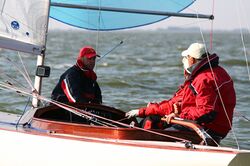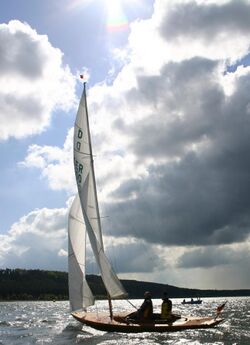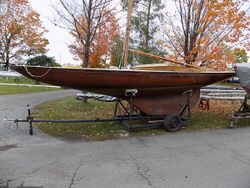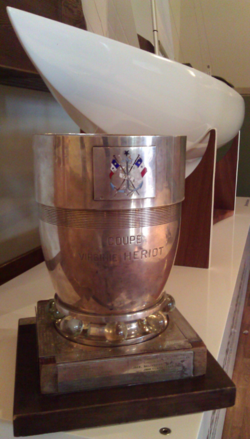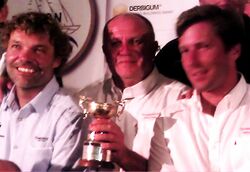Engineering:Dragon (keelboat)
 Class symbol | |
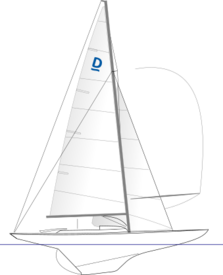 | |
| Development | |
|---|---|
| Designer | Johan Anker |
| Location | Norway |
| Year | 1929 |
| Design | One-Design |
| Boat | |
| Crew | 2–4 Maximum crew weight: 285 kg (628 lb) |
| Draft | 1.20 m (3 ft 11 in) |
| Hull | |
| Type | Monohull |
| Construction | Carvel GRP Cold moulded plywood Composite |
| Hull weight | 1,700 kg (3,700 lb) |
| LOA | 8.90 m (29.2 ft) |
| LWL | 5.66 m (18.6 ft) |
| Beam | 1.95 m (6 ft 5 in) |
| Hull appendages | |
| Keel/board type | Fixed |
| Rig | |
| Rig type | Bermuda rig |
| Sails | |
| Mainsail area | 16.0 m2 (172 sq ft) |
| Jib/genoa area | 11.7 m2 (126 sq ft) |
| Spinnaker area | 23.6 m2 (254 sq ft) |
| Upwind sail area | 27.7 m2 (298 sq ft) |
| Racing | |
| D-PN | 89.5 |
| RYA PN | 986 |
| Former Olympic class | |
The Dragon is a one-design keelboat designed by Norwegian Johan Anker in 1929. In 1948 the Dragon became an Olympic Class, a status it retained until the Munich Olympics in 1972. The Dragon's long keel and elegant metre-boat lines remain unchanged, but today Dragons are constructed using the latest technology to make the boat durable and easy to maintain. GRP construction was introduced in 1973 and the rigging has been regularly updated.[1]
The Dragon class is actively represented in over 26 countries on 5 continents. By 2004 there were 1,444 boats registered, and the number of boats built has averaged 45 per year. There are many more which are used for day sailing. The World Championships are held in every odd year and the European Championships are held annually. The Gold Cup, which can only be held in certain specified European countries, is unique in that all six races count without discard. It is held annually and often attracts over 100 entries, usually starting in one fleet.
A strong Class Association manages the class rules carefully to ensure safety, high quality and uniformity. Spars and sails have a wide range of adjustment during racing, allowing a skillful crew to optimize the boat for any conditions. Crew weight limits and restrictions on hiking out allow the Dragon to be raced successfully by a range of ages and both genders. It is possible to tow the Dragon behind many vehicles. It is often dry-sailed.[clarification needed] It may be raced against boats of other classes, employing a Portsmouth Yardstick handicap of 986[2] or a D-PN of 89.5.[3]
History
The Dragon class was initiated by the Royal Gothenburg Yacht Club, who gave Norwegian yacht designer Johan Anker a brief for a cheap cruising/racing boat with about 20 square metres (220 sq ft) of sail area.[4] After the Second World War, the boat was considered slow, and genoa and spinnaker were introduced.[4]
The Dragon was one of the Vintage Yachting Classes in the Vintage Yachting Games in 2008 and 2012.
Events
Olympic Games
Source:[5]
|-
| style="align:center;" | 1948 London
|style="vertical-align:top;" |Norway (NOR)
Thor Thorvaldsen
Haakon Barfod
Sigve Lie |style="vertical-align:top;" |Sweden (SWE)
Folke Bohlin
Gösta Brodin
Hugo Johnson |style="vertical-align:top;" |Denmark (DEN)
William Berntsen
Klaus Baess
Ole Berntsen
|-
| style="align:center;" | 1952 Helsinki
|style="vertical-align:top;" |Norway (NOR)
Thor Thorvaldsen
Haakon Barfod
Sigve Lie |style="vertical-align:top;" |Sweden (SWE)
Per Gedda
Erland Almqvist
Sidney Boldt-Christmas |style="vertical-align:top;" |Germany (GER)
Theodor Thomsen
Erich Natusch
Georg Nowka
|-
| style="align:center;" | 1956 Melbourne
|style="vertical-align:top;" |Sweden (SWE)
Folke Bohlin
Bengt Palmquist
Leif Wikström |style="vertical-align:top;" |Denmark (DEN)
Ole Berntsen
Cyril Andresen
Christian von Bülow |style="vertical-align:top;" |Great Britain (GBR)
Graham Mann
Ronald Backus
Jonathan Janson
|-
| style="align:center;" | 1960 Rome
|style="vertical-align:top;" |Greece (GRE)
HRH Crown Prince Constantine
Odysseus Eskidioglou
Georgios Zaimis |style="vertical-align:top;" |Argentina (ARG)
Jorge Salas Chávez
Héctor Calegaris
Jorge del Río Sálas |style="vertical-align:top;" |Italy (ITA)
Antonio Cosentino
Antonio Ciciliano
Giulio De Stefano
|-
| style="align:center;" | 1964 Tokyo
|style="vertical-align:top;" |Denmark (DEN)
Ole Berntsen
Christian von Bülow
Ole Poulsen |style="vertical-align:top;" |Germany (EUA)
Peter Ahrendt
Wilfried Lorenz
Ulrich Mense |style="vertical-align:top;" |United States (USA)
Lowell North
Richard Deaver
Charles Rogers
|-
| style="align:center;" | 1968 Mexico City
|style="vertical-align:top;" |United States (USA)
George Friedrichs
Barton Jahncke
Gerald Schreck |style="vertical-align:top;" |Denmark (DEN)
Aage Birch
Poul Richard Høj Jensen
Niels Markussen |style="vertical-align:top;" |East Germany (GDR)
Paul Borowski
Karl-Heinz Thun
Konrad Weichert
|-
| style="align:center;" | 1972 Munich
|style="vertical-align:top;" |Australia (AUS)
John Cuneo
Thomas Anderson
John Shaw |style="vertical-align:top;" |East Germany (GDR)
Paul Borowski
Karl-Heinz Thun
Konrad Weichert |style="vertical-align:top;" |United States (USA)
Donald Cohan
Charles Horter
John Marshall
|}
World Championships
Source:[6]
Vintage Yachting Games
Source:[7]
Template:Medals table
|-
| 2008 Medemblik
| ![]() Netherlands (NED)
Netherlands (NED)
Reinier Wissenraet
Gijs Evers
Marc Reijnhoudt
| ![]() United Kingdom (GBR)
United Kingdom (GBR)
Miss Gavia Wilkimson-Cox
Ron Rosenberg
Jon Mortimer
| ![]() Australia (GER)
Australia (GER)
Gordon Ingate
David Giles
Keith Musto
|-
| 2012 Lake Como
| ![]() Ukraine (UKR)
Ukraine (UKR)
Yevgen Braslavetz
Georgii Leonchuk
Sergey Timokhov
| ![]() Netherlands (NED)
Netherlands (NED)
Reinier Wissenraet
Pim ten Harmsen van der Beek
Marc Reijnhoudt
| ![]() Russia (RUS)
Russia (RUS)
Vasiliy Senatorov (ru)
Igor Ivashintsov
Aleksandr Muzychenko
|-
| 2018 Copenhagen
| No Dragon representation.
|
|
|}
European Championships
Source:[8]
In memory of Madame Virginie Hériot and in accordance with her often expressed wish to encourage yachting, the Committee of the Yacht Club de France decided at a meeting on 21 May 1946 to initiate an International Cup and name it the "Coupe Virginie Hériot". The Cup is assigned to the International Dragon Class, but remains the property of the Yacht Club de France. In agreement with the Committee of the International Dragon Association the "Coupe Virginie Hériot" is the main trophy of the European Dragon Championship. The event is now held annually.
Gold Cup
The International Dragon Cup was presented in 1937 by members of the Clyde Yacht's Conference with the intention of bringing together as many competitors of different nationalities as possible for yacht racing in Europe in a friendly spirit, in order to perpetuate the good feeling which existed at the first International Clyde Fortnight. The Clyde Yacht Clubs' Conference has been reconstituted as the Clyde Yacht Clubs' Association and the International Dragon Cup has become known as, and is now renamed, the 'Dragon Gold Cup'.
Members of the Clyde Yacht Clubs' Association created specific rules for this competition and donated a perpetual trophy made of pure gold for an annual international race. From the beginning, the Gold Cup was considered a family event for the Dragon Sailors and could be raced by yachts of the International Dragon Class belonging to any country, and for this reason was a very well attended event.
Until 1965, the year of the first Official World Championship, the Gold Cup was considered the unofficial World Cup. The first rules created by the Clyde Yacht Clubs' Association established that the Cup should be sailed annually and that the Cup should be retained by the winner for one year only. It also established that the event should take place in rotation in the following countries: Scotland, France, Sweden, Germany, Holland and Denmark.
With the revision of the rules in 1997, the number of hosting countries was enlarged to eleven: Belgium, Denmark, France, Germany, Ireland, Netherlands, Norway, Portugal, Spain, Sweden and the United Kingdom.
The hosting country and the Organising Authority continue to be selected by the Clyde Yacht Clubs' Association in conjunction with the International Dragon Association and the number of participants was limited to 120.
Class association
Source:[10]
The International Dragon Association (IDA) was founded on 31 October 1961 with London as its headquarters. The principal objects of the IDA are:
- To further the interests of the International Dragon Class in all countries where Dragons are sailed and to introduce the Class to new countries.
- To be responsible for the administration of the class rules and coordinating proposals for rule amendments for consideration by the International Sailing Federation (ISAF).
- To ensure that the class retains its "International" status by complying with the criteria adopted by the ISAF.
- To co-ordinate and select venues for the following international championships:
- World Championships
- European Championships
- Gold Cups
- To produce regular newsletters containing information about the Class and the activities of the IDA for distribution to all Dragon sailors throughout the world.
- Membership is open to National Dragon Class Associations.
Class officers
President
Vice-Presidents
- H.R.H. Crown Prince Frederik of Denmark
- Christopher Dicker
- Poul Richard Høj Jensen
Chairman
| Period | Country | Chairman | Major achievement |
| 1961–1965 | Sir Gordon Smith | ||
| 1966 | F Thierry-Mieg | ||
| 1967–1969 | Sir Gordon Smith | ||
| 1970–1972 | F Thierry-Mieg | ||
| 1973–1975 | P Dyas | ||
| 1976–1978 | P Manset | ||
| 1979–1981 | P Dyas | ||
| 1982–1984 | P Manset | ||
| 1985–1988 | C Doyle | ||
| 1989–1992 | N Geissler | ||
| 1993–1994 | T Nurmilaukas | ||
| 1995–1996 | Chris Dicker | ||
| 1997–2000 | C. R. Ferreira | ||
| 2001–2004 | Thomas Olrog | ||
| 2005–2006 | Rupert Fischer | ||
| 2007–2010 | Rob Campbell | ||
| 2011–2015 | Richard Blickman | ||
| 2015–2019 | ÎÎÎÎÎ | ||
| 2019–2021 | Jens Rathsack | ||
| 2021– | Gerard Blanc |
References
- ↑ "Some history of the Dragon class at britishdragons.org". http://www.britishdragons.org/racing-dragons.aspx.
- ↑ "RYA Portsmouth Yardstick Scheme 2007". Royal Yachting Association. http://www.benfleetyachtclub.org/files/Portsmouth_HC/2007_Handicap_List.pdf.
- ↑ "Keelboat Classes". US Sailing. http://offshore.ussailing.org/Portsmouth_Yardstick/Current_Tables/Keelboat_Classes.htm.
- ↑ 4.0 4.1 Bremberg, Fred; Seth, Staffan (1965) (in sv), Segelbåtstyper: kortfattade beskrivningar med igenkänningstecken och dimensionsuppgifter för svenska segelbåtar (2nd revised ed.), Stockholm: Aldus/Bonnier, p. 64
- ↑ "Olympic results at sports123.com". http://sports123.com/sai/oo-dra.html.
- ↑ World champions at sports123.com
- ↑ Vintage Results vintageyachtinggames.org. Retrieved 3 January 2021
- ↑ European championship results International Dragon Class Association. Retrieved 3 January 2021
- ↑ Gold Cup winners International Dragon Class Association. Retrieved 3 January 2021
- ↑ Homepage International Dragon Class Association. Retrieved 3 January 2021
External links
- Classic Boat's guide to Dragon Class
- International Dragon Class Association WebPage
- Australian Class Link
- USA/CAN Class LInk
- UK Class LInk
- French Class Link
- Dutch Dragon Class
- Belgian Dragon Class
 |
